
Horse Coins

Images of horses also appear on old Chinese chess pieces and examples can be seen at Ancient Chinese Chess (Xiangqi) Pieces.
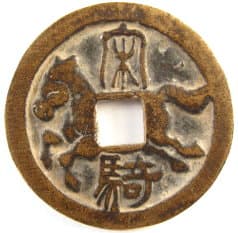 Horse
coins
are usually made of bronze or copper although, in some
rare cases, ivory and horn were used. Most common
horse coins measure around 3 centimeters in diameter with
a square or circular central hole.
Horse
coins
are usually made of bronze or copper although, in some
rare cases, ivory and horn were used. Most common
horse coins measure around 3 centimeters in diameter with
a square or circular central hole.
The horses depicted on the coins vary in position. Some are lying on the ground sleeping. Others are turning their head and neighing. Or, as in the example shown here, the horse is shown galloping forward with its tail raised high. Unfortunately, the horse's saddle always seems to be at the central hole of the coin which prevents us from learning more about this aspect of ancient Chinese culture.
Among all the horse coins, those made in the Song
Dynasty (960-1279 AD) are considered to be the finest.
They were made from high-quality metal and with fine
detail. The coin shown at left is representative of
the Song horse coins although it would be difficult to
confirm that this particular piece dates from that period.
Horse coins display many of the most famous
horses in Chinese history. For instance, in the early
Western Zhou Dynasty (c. 11th century-771 BC), King Mu
(穆王) once rode on a chariot with eight outstanding
steeds. The names of the eight horses can be found
on horse coins although there is some disagreement as to
which set of eight names passed down through history is
correct. The names of King Mu's horses described
their outstanding characteristics and included "Beyond
Earth", "Rush by Night", "Windswept Plumes", "Finer
than Flashing Light", "Faster than Shadow", "Wing Bearer",
"Faster than Light" and "Rising Mist". Other
historical texts list King Mu's horses as "Bay Steed",
"Smoked Ebony", "Skewbald Chestnut", "Great Yellow" and
"Green Ear".
There are also horse coins depicting the victorious,
yet ruthless, General Bai Qi of the ancient Kingdom of Qin
during the Warring States Period (475-221 BC).
When Qin Shi Huang put an end to the Warring States Period and united China into the first empire (221-207 BC), he chose the seven best horses from the thousands of military horses who had fought in the battles.
In order to improve the quality of his stable, Emperor
Wudi of the Western Han Dynasty (206 BC - 24 AD) searched
for the best stallions outside his empire. To get the
mysterious hanxue
(sweating blood) horse which he believed were the divine
"Horses of Heaven" that could be ridden to immortality, he
fought a three-year war beginning in 101 BCE against a
small kingdom (Ferghana) located in today's
Uzbekistan. While the emperor's army captured some
3,000 hanxue
horses, only about 1,000 survived the long trip home. Many
legends and historical records state that when such horses
galloped, their sweat was the color of blood. Some
modern scientists now attribute the "blood" sweat to the
parasites which infested the tissues beneath the skin of
the horses. After strenuous movement, the blood
would flow out with the sweat. (Please see "Sweating
Blood Horse" Coin for a detailed discussion.)
Another set of famous horses depicted on horse coins
is associated with Emperor Taizong (Li Shimin) of the Tang
Dynasty (618-907 AD). These horses are also
celebrated in a famous relief sculpture outside his tomb
and are known as the "Six Chargers of Emperor Taizong".
Finally, a very few horse coins will display a rider
on the horse in order to commemorate famous battles from
ancient Chinese history. Please see the "Battle
of
Jimo"
Horse
Coin as an example.
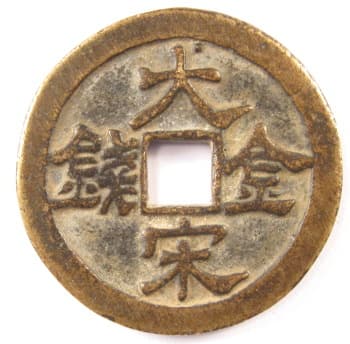
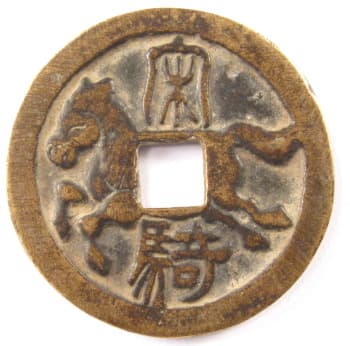
The Chinese characters on the obverse side of this old horse coin read da song jin qian (大宋金钱) which means "Great Song (dynasty) metal money".
The reverse side shows a galloping horse with the inscription song qi (宋骑) which means "a rider of the Song (dynasty)".
The coin is 37.7mm in diameter and weighs 18.1 grams.
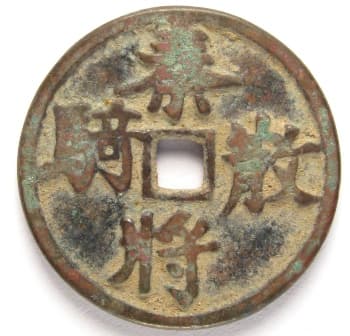
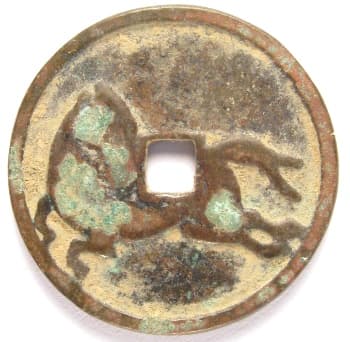 The inscription on
this horse coin is qin
jiang san qi (秦将散骑).
The inscription on
this horse coin is qin
jiang san qi (秦将散骑).Qin jiang (秦 将) refers to a general from the ancient state of Qin during the Warring States period (475-221 BC).
The general referred to is General Bai Qi (白起), a ruthless military leader, who won more than 70 battles. Following each victory, he would order his men to slaughter the defeated soldiers. Historical records credit him with the slaughter of hundreds of thousands of enemy soldiers.
General Bai Qi was forced to commit suicide by the King of Qin in the year 257 BC.
San qi (散 骑) in ancient Chinese has the meaning of shi cong (侍从) which means "followers".
The inscription therefore refers to the attendants or followers of General Bai Qi who would advise or counsel him.
The reverse side of the coin depicts a galloping horse.
The coin has a diameter of 27.5 mm and a weight of 9 grams.
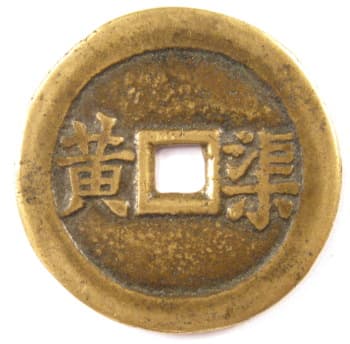
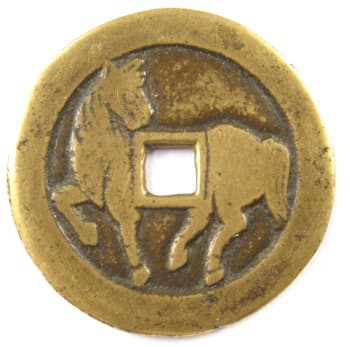
This horse coin depicts Qu Huang (渠黄), meaning "Great Yellow", which was one of the eight great horses mentioned above of King Mu of the Western Zhou Dynasty.
This particular specimen is 35 mm in diameter and weighs 11.9 grams.
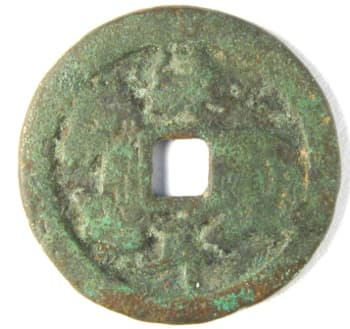
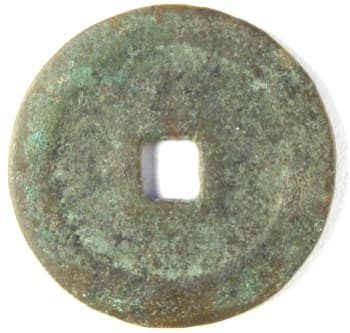 This is
another horse coin honoring one of King Mu's famous horses.
This is
another horse coin honoring one of King Mu's famous horses.The obverse side of the coin, at the far left, displays a galloping horse.
The two character inscription, with one Chinese character above and one character below the square hole, reads lu er (绿耳).
The heavy green patina on the coin is appropriate because lu er translates as "Green Ear".
The reverse side of the coin is blank.
The coin has a diameter of 28 mm and weighs 7.4 grams.
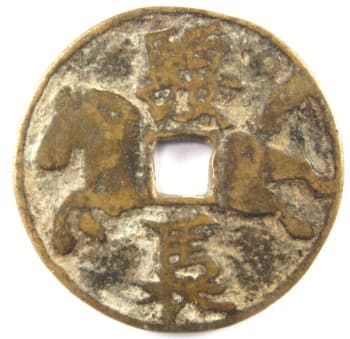
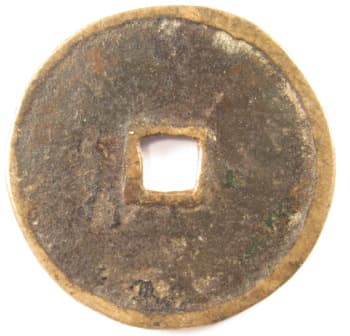
The inscription on the obverse side of this horse coin
reads piao niao
(骠袅) which translates as "fast and slender".
The reverse side is blank.
The coin is 27 mm in diameter and weighs 6 grams.
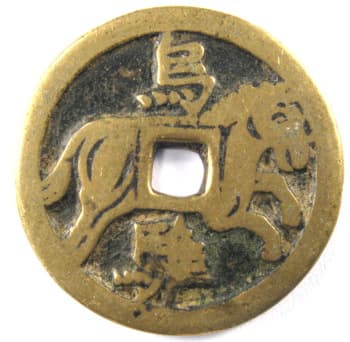
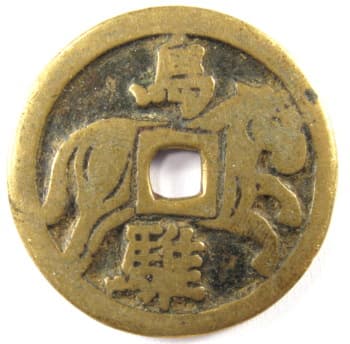
This "double obverse" horse coin has the inscription wu zhui (乌骓) which
means a "black spotted horse".
The diameter of the coin is 30mm and the weight is 9 grams.
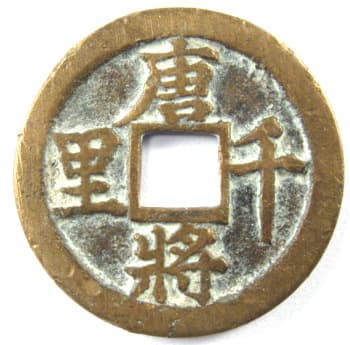
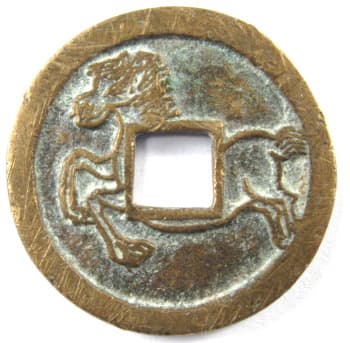
The obverse of this coin reads tang jiang qian li (唐将千里) which literally means "Tang General 1,000 li ".
The coin is 27mm in diameter and weighs 5.5 grams.
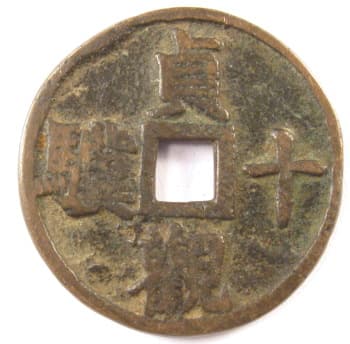
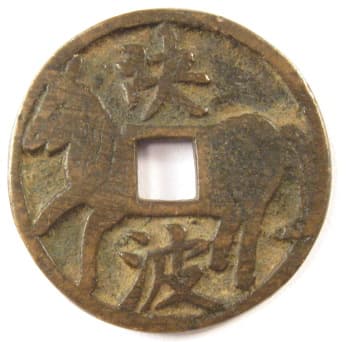
The inscription on the obverse side of this horse coin is read top to bottom and right to left as zhen guan shi ji (贞观十骥) which means "ten thoroughbreds of Zhen Guan". Zhen Guan refers to the era during which Emperor Taizong (Li Shimin) of the Tang Dynasty (618-907 AD) ruled.
The Chinese characters on the reverse side are jue bo (诀波) which was the name of one of these horses. Jue Bo would roughly translate as "bursting as a wave".
The coin is 30mm in diameter and weighs 9.7 grams.
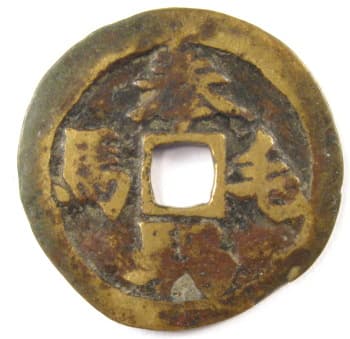
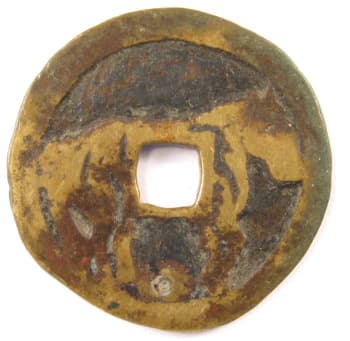 This horse coin commemorates Quanmaogua (拳
毛騧) which was the famous war horse that Li
Shimin (李
世民), who later became Emperor
Taizong (唐太宗 626-649 AD) of the Tang
dynasty, rode in the battle defeating Liu Heita
(刘
黑闼) in 622 AD.
This horse coin commemorates Quanmaogua (拳
毛騧) which was the famous war horse that Li
Shimin (李
世民), who later became Emperor
Taizong (唐太宗 626-649 AD) of the Tang
dynasty, rode in the battle defeating Liu Heita
(刘
黑闼) in 622 AD.Quanmaogua died on the battlefield after being hit by 9 arrows, 6 in the chest and 3 in the back.
The inscription, which is read in a clockwise manner beginning with the character at the top, is quan mao gua ma (拳毛騧马).
The literal translation is "fist hair piebald horse". Actually, the name is believed to be a transliteration of Turkic into Chinese. Turkic is a language from Central Asia where the horse may have originally come.
"Fist hair" (拳毛) refers to circular hair. "Piebald" (騧) translates as a yellow horse (马) with a black mouth.
Scholars now believe that the name Quanmaogua was probably meant to describe a horse that had curly yellow hair.
During the time of the Sui and Tang dynasties, people would have considered a horse with these characteristics to be rather ugly (丑). General Li Shimin, however, had the ability to identify a horse that had the qualities needed to help him succeed in battle even though the animal may have been physically unattractive.
According to the Penn Museum, the name Quanmaogua indicates a "saffron-yellow horse with a wavy coat of hair".
Quanmaogua is one of the six horses immortalized in stone reliefs at the Zhao Mausoleum (昭 陵), Emperor Taizong's mausoleum, located at Xi'an (西 安). These white marble stone reliefs are known as the Six Steeds of the Zhao Mausoleum (唐 昭陵六骏石刻) and are 2.5 meters tall and 3 meters wide.
Four of the six stone reliefs are in China and displayed at the Stele Forest (Beilin Museum 碑 林) in Xi'an. The stone relief of Quanmaogua, as well as the one for Saluzi ("Autumn Dew" 飒 露紫), were stolen in 1914 and sold by C.T. Loo (Ching Tsai Loo 卢 芹斋) in 1918 to the Penn Museum at the University of Pennsylvania (宾夕法尼亚大学) where they are on display.
The coin is 31mm in diameter and weighs 9.5 grams.
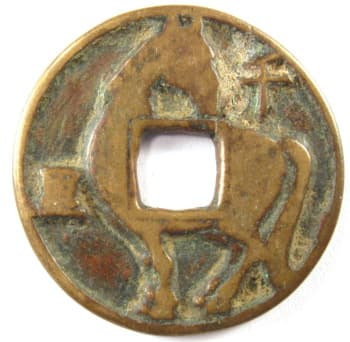
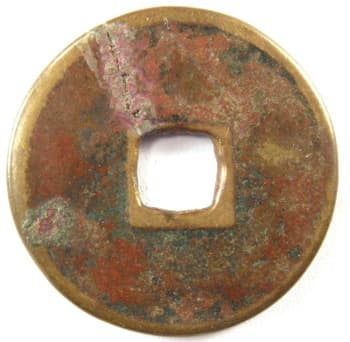
The Chinese characters qian li (千里) on this horse coin mean "1,000 li ". The li (里) was a measure of distance in ancient China which varied over history. One li was equal to roughly 300 - 400 meters.
The term qian li or "1,000 li" refers to the ancient accomplishment of Zhaofu who was the carriage driver of King Mu of the Western Zhou Dynasty. Zhaofu was able to cover a distance of 1,000 li in a single day in order to return King Mu from a hunting trip in time to put down a rebellion in the capital.
The coin is 28mm in diameter and weighs 6.4 grams.
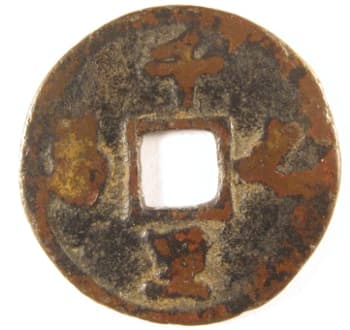
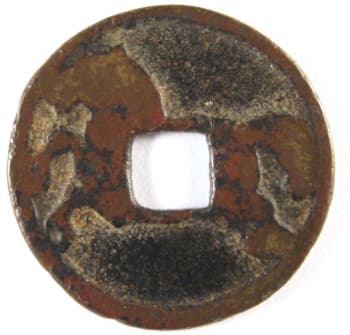
This old horse coin shows considerable wear.
The inscription is similar to the above coin and reads qian li zhi ma (千里之马) which translates as "1,000 li horse".
The coin has a diameter of 27mm and a weight of 5.2 grams.
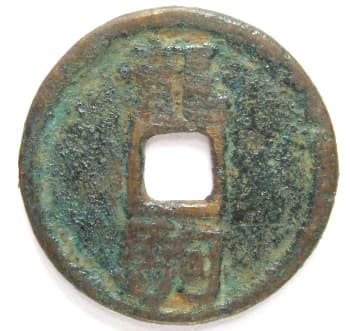
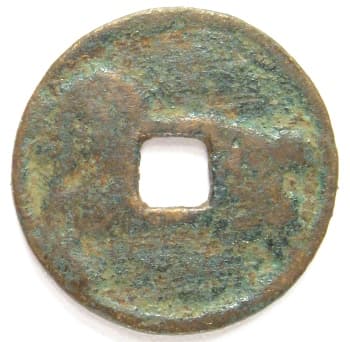 The inscription on the obverse side of this
old Chinese horse coin is long
ju (龙驹) which translates as "Dragon's Colt".
The inscription on the obverse side of this
old Chinese horse coin is long
ju (龙驹) which translates as "Dragon's Colt".The reverse side depicts a "dragon colt" horse.
Dragon colt usually refers to a horse that is white and tall.
The term long ju (龙驹) can be traced back to the ancient Chinese text the "Rites of Zhou" (zhou li 周礼) which dates to the second century BC and is considered one of the classics of Confucianism. This ancient ritual text describes a "dragon colt" as a horse which is "more than eight chi (尺) tall" measured from the front hoof to the shoulder. One chi, during the time of the Zhou, was about 16.5 centimeters.
The coin has a diameter of 23 mm and a weight of 3.4 grams.
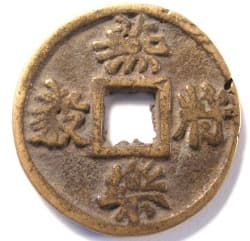
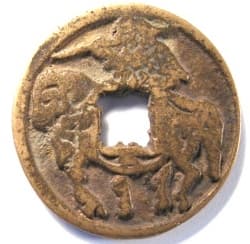 Horse coins typically
honor only famous horses but a few of these coins display a
rider on the horse in order to commemorate famous battles
from ancient Chinese history.
Horse coins typically
honor only famous horses but a few of these coins display a
rider on the horse in order to commemorate famous battles
from ancient Chinese history.The horse coin at the left has the inscription yan jiang yue yi (燕將樂毅) which translates as General Yue Yi of the State of Yan. (Sometimes the name is translated as General Le Yi.)
The reverse side of the coin shows General Yue Yi carrying a weapon while on horseback.
General Yue Yi played a major role in one of the most famous battles of ancient China.
This coin and the "Battle of Jimo" which it commemorates is discussed in detail at "Battle of Jimo" Horse Coin.
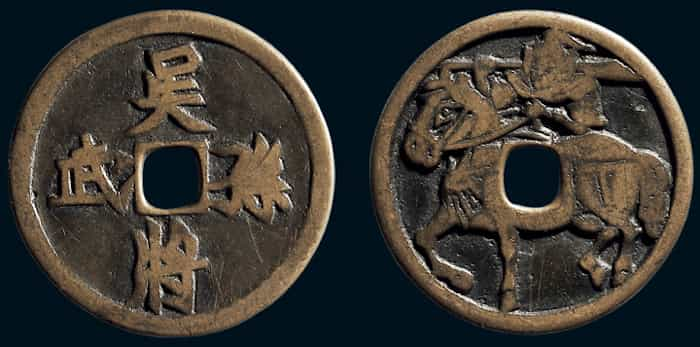 This
horse coin commemorates one of the most famous generals in
Chinese history.
This
horse coin commemorates one of the most famous generals in
Chinese history.The inscription reads wu jiang sun wu (吴将孙武) which translates as "Sun Wu (孙武) the General (将) of the State of Wu (吴)".
Sun Wu is better known nowadays as Sun Tzu or Sunzi.
Sun Tzu (544-496 BC) is the famous general and military strategist who wrote the book "The Art of War" (孙 子兵法) during the Spring and Autumn period (春 秋时代 770-476/403 BC).
The reverse side of the horse coin portrays Sun Tzu carrying a sword over his shoulder while riding his horse.
This horse coin was sold at China Guardian Auction in 2013.
Rare horse coins from the Song and Yuan dynasties displaying horses in battle armor are discussed at Horse in Armour Horse Coins.
A rare horse coin depicting a blood-sweating "heavenly horse" is discussed at "Sweating Blood Horse" Coin.
Return to Ancient Chinese Charms and Coins